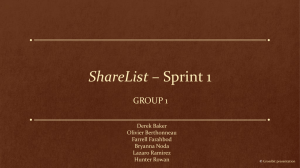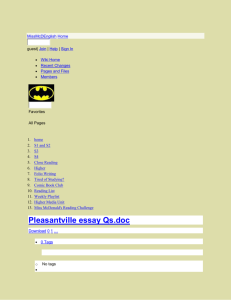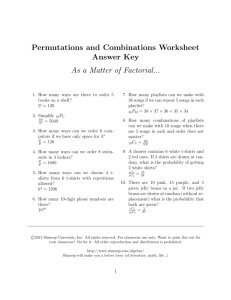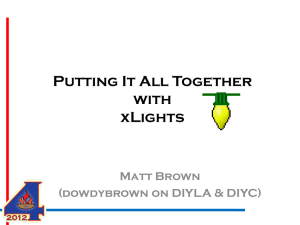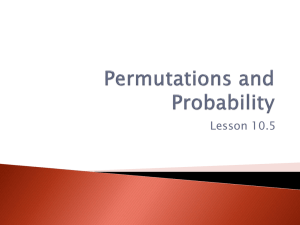Scroll-Point-and-Click Composition?: The Generic Complexities of
advertisement
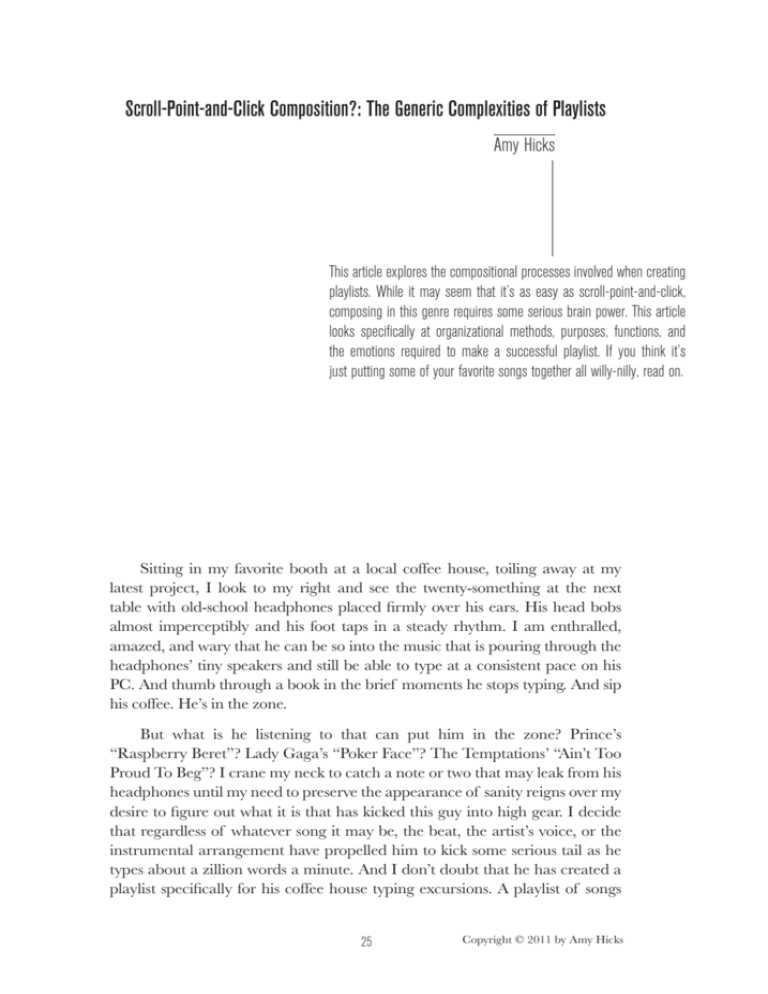
Scroll-Point-and-Click Composition?: The Generic Complexities of Playlists Amy Hicks This article explores the compositional processes involved when creating playlists. While it may seem that it’s as easy as scroll-point-and-click, composing in this genre requires some serious brain power. This article looks specifically at organizational methods, purposes, functions, and the emotions required to make a successful playlist. If you think it’s just putting some of your favorite songs together all willy-nilly, read on. Sitting in my favorite booth at a local coffee house, toiling away at my latest project, I look to my right and see the twenty-something at the next table with old-school headphones placed firmly over his ears. His head bobs almost imperceptibly and his foot taps in a steady rhythm. I am enthralled, amazed, and wary that he can be so into the music that is pouring through the headphones’ tiny speakers and still be able to type at a consistent pace on his PC. And thumb through a book in the brief moments he stops typing. And sip his coffee. He’s in the zone. But what is he listening to that can put him in the zone? Prince’s “Raspberry Beret”? Lady Gaga’s “Poker Face”? The Temptations’ “Ain’t Too Proud To Beg”? I crane my neck to catch a note or two that may leak from his headphones until my need to preserve the appearance of sanity reigns over my desire to figure out what it is that has kicked this guy into high gear. I decide that regardless of whatever song it may be, the beat, the artist’s voice, or the instrumental arrangement have propelled him to kick some serious tail as he types about a zillion words a minute. And I don’t doubt that he has created a playlist specifically for his coffee house typing excursions. A playlist of songs 25 Copyright © 2011 by Amy Hicks 26 Grassroots Writing Research Journal that gets him motivated, allows his fingers to fly effortlessly over his laptop’s keyboard, and causes him to be immersed in music that, for him, says “get this homework done now.” Most of us make special playlists for different occasions and situations: The Yeah Yeah Yeahs and Spoon for working out at the gym, Bach and Schubert for studying in the library, The Black Keys and The Moaners for walking from class to class. (Heck, I’m listening to The Scissor Sisters—my goto typing music—as I write this piece.) These playlists, no matter what type(s) of music they may be, are created with a specific purpose in mind. The songs amp you up, calm you down, or keep you moving. These songs are made for walking through the quad, running on the treadmill, and solving an equation for math class. The songs seem to “fit” a particular occasion or activity. But how do we make these songs “fit” these various situations? The genre of playlists seems so straightforward, uncomplicated, and easy to define. I think most of us would agree that a playlist is a list of songs, grouped together on some sort of device—mp3 player or iPod, computer, or CD—to serve a certain function. Simply put, you select a song, then another, and another, until you have a nice little list of tracks, created by you for your own listening pleasure. And modern technology has certainly made creating personal playlists less time-consuming. It’s as easy as scroll-point-and-click. Nevertheless, when you really think about it, maybe this genre is not as simple as it seems. The ability to sequence songs in a specific order takes thought and considerable attentiveness to the mood or the things that we wish to accomplish while listening to a playlist. For example, Laura has a “go to sleep” playlist. As opposed to the playlist that I imagine the guy at the coffee shop had that propelled him to push through taxing schoolwork, Laura’s playlist is composed for a very different, yet very specific, purpose. For her playlist, she uses songs to lull her to sleep. After talking with Laura a bit more, I learned that composing this particular playlist is full of various twists and turns. She notes, “I try to listen to songs that I don’t know the lyrics to (so I can’t sing along in my head and my mind isn’t busy while I’m trying to fall asleep). They are peaceful songs, they especially are not ‘screamo’ or hard rock” (Fromme). Notice that Laura thoughtfully considers not only how songs can help her fall asleep, but also what it is exactly about these songs that produces this effect. She realizes that knowing every lyric to a song may make her mind “busy,” and this will not generate a serene “go to sleep” experience for her. Also, Laura thinks critically about what genre of music is appropriate for her playlist. She identifies acoustic and indie Hicks — Scroll-Point-and-Click Composition? 27 music as good choices and notes that “‘screamo’ or hard rock” are not suitable choices for this playlist. Laura literally composes a playlist by choosing very specific songs that will affect a certain experience she wants to have, and most interestingly, she places these tracks in a specific sequence: “Goodnight Laura” by Spoon first, ones that she doesn’t know the lyrics to next, and then some of her favorite songs that she does know the lyrics to at the end. Since she figures that she will already be asleep by the time her favorite songs are playing, Laura believes that these tracks won’t be a distraction. Put simply, it seems that there is a lot of thought put into the organization of this playlist. Let’s take a look at another example. Brock organizes his playlists in a very interesting way—by designating them with specific categorical titles. He notes, “If I’m feeling happy or excited, I listen to my playlist titled Happy. If I need to study or relax, I play my playlist titled Relax and so long and so forth” (Harrell). Brock pays special attention to the emotion that he wishes to have or activity that he wishes to complete when choosing a playlist to listen to. This attention to mood and activity doesn’t seem too different than what most people experience when they title their playlists. But this is where it gets more complicated: Brock spends a lot of time thinking about which song will go where and in which playlist. Instead of the simple scroll-point-and-click compositional method I discussed above, he carefully attends to how each song makes him feel before moving a track into a category. Brock describes his organizational process here: In order for songs to be placed into the appropriate categories, I have to listen to each one a TON of times so that I can see how it makes me feel. Sometimes a song that’s supposed to be happy can make me sad and vice versa. I truly need to almost memorize the lyrics before I can ever make a final decision as to where I should put it. That’s why before I put a song in any special playlist it has to start off in the playlist titled Brock’s. Once I’ve listened to it enough times I then switch it to the appropriate category and then repeat the steps all over again for a new song. (Harrell) Brock’s explanation clearly shows how much time, effort, and thought he puts into composing each playlist and illustrates that his organizational processes are anything but straightforward. His process involves multiple steps: listening, thinking, memorizing, moving tracks to different spots, etc. But perhaps the more important things to note are that this process makes sense for Brock and that he created these organizational strategies to benefit his composition of personal playlists. Both Laura’s and Brock’s processes show how composing in this genre requires a certain amount of logic. They must think about the songs, the order in which to put them, and how they want to designate these lists with titles or 28 Grassroots Writing Research Journal categories. Yet, their compositional methods are deeply rooted in the personal as well. Laura’s bedtime playlist is a one-of-a-kind text—it’s safe to say that no one else would compose a playlist that is identical to hers. While I’m sure lots of people have specific playlists created for the purpose of going to sleep, it’s unlikely that others will think to choose the exact tracks that Laura did. Even if someone did select the same songs, would they put them in the same order? Moreover, if Laura shared her playlist with someone else, would listening to it elicit the same response for this person? Very unlikely. And for Brock, he has consciously established a method of organization that works for him, and the way in which he composes his playlist is a highly individualized process. But what is perhaps even more striking about Brock’s mode of organization is that his emotional state profoundly influences his ability to group his tracks under appropriate designations. He must tap into not only what he is feeling at a particular moment in time but also how his emotions could be heightened or influenced by particular songs placed into a specific, aptly titled playlist. Rational thought and emotion drive his admittedly time-consuming and even taxing mode of organization and composition. Thinking about what we like and how we feel seems to come to us naturally, and I don’t know if we consciously contemplate these things very often, much less question why we like these things and why we feel certain ways. Yet, for Brock, he deliberately explores these regularly taken-for-granted sensations. And it is precisely the act of composing in this genre that compels him to do just this. To compose successful playlists, although they seem so simple to create, actually requires us to use a good bit of brain power. We have to think about various components, whether it is song selection, genre of music, purpose of the completed playlist, what emotion we want to experience, etc., as Laura’s and Brock’s compositional processes have clearly evidenced. So, is composing in this genre really as easy as scroll-point-and-click? Acknowledgements: Special thanks to Molly Bindon, Diana Civitello, Laura Fromme, Kevin Gadzala, Brock Harrell, Kirsten Schroeder, Kylie Sieja, and Kara Sotiroff for their help with this article and their input about their personal playlists. Works Cited Fromme, Laura. “Re: Playlist EC.” 11 Dec. 2010. Harrell, Brock. “Ipod playlists.” 30 Nov. 2010. Hicks — Scroll-Point-and-Click Composition? 29 Amy Hicks is a native Mississippian (y’all) and moved to Normal to pursue a PhD in English Studies. When she’s not reading, writing, or teaching, she’s probably watching reality TV and catching up on celebrity gossip.
